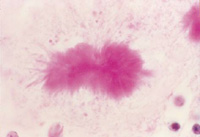
As more is learned about how cancer develops, scientists have begun designing new drugs that directly target cancer cells, leaving healthy ones intact. Having fewer side effects, some of these drugs work by blocking growth signaling processes within cancer cells, while others enlist the body’s immune system to recognize and mount an attack against the cancer cell. But regardless of how they work, most of these drugs are designed to treat a specific cancer and cannot be used to treat other tumor type

Research led by scientists at the U of T and Caprion Pharmaceuticals have uncovered the basis for a diagnostic, immunotherapy and vaccine, providing a way to detect and treat the brain-wasting damage of infectious prions like those found in mad cow disease and its human version, Creutzfeldt-Jakob Disease.
Dr. Neil Cashman, a principal investigator at U of T’s Centre for Research in Neurodegenerative Diseases and professor in the Department of Medicine (neurology) and a Caprion founder,

An experimental cancer drug named bevacizumab (trade name Avastin) is the first “anti-angiogenesis” drug to prove that it can shrink tumors and extend survival in patients with metastatic colorectal cancer, according to a national clinical trial led by researchers at the Duke Comprehensive Cancer Center.
Bevacizumab is known as an anti-angiogenesis drug because it blocks the formation of blood vessels in tumors (a process called angiogenesis) and thus inhibits their growth.
Patien

Researchers at the Breast Care Center at Baylor College of Medicine and The Methodist Hospital have developed a new test to predict which breast cancer tumors will respond to chemotherapy, potentially reducing unnecessary treatment for women with breast cancer, according to data presented at the American Society of Clinical Oncology annual meeting in Chicago.
Using novel DNA array technology, the study identified differences in the gene patterns from tumor samples that predict which patients

Study results presented at the 39th annual meeting for the American Society of Clinical Oncology (ASCO) by Chandra P. Belani, M.D., professor of medicine, University of Pittsburgh and co-director, Lung Cancer Program, University of Pittsburgh Cancer Institute (UPCI), demonstrate that a new therapeutic radiation strategy for non-small cell lung cancer (NSCLC) – the most common form of the disease – leads to improved survival for lung cancer patients with locally advanced disease.
n the study

By combining genes from three separate organisms into a single bacterial factory, University of California, Berkeley, chemical engineers have developed a simpler, less expensive way to make an antimalaria “miracle” drug that is urgently needed in Third World countries.
The drug, artemisinin, is one of the most promising next-generation antimalarials because of its effectiveness against strains of the malaria parasite now resistant to front-line drugs. It is now too expensive for broad use i

– new calculation confirms standard model of particle physics. Contribution of hadronic vacuum polarization determined with unprecedented accuracy. The magnetic moment of the muon is an important precision parameter for…
Technique may prevent formation of unwanted waves that siphon off needed energy. Heating plasma to the ultra-high temperatures needed for fusion reactions requires more than turning the dial on a…

An international team of astronomers, led by researchers from the Astronomical Observatory of the University of Warsaw, have identified a new class of cosmic X-ray sources. The findings have been…

How deubiquitinases USP53 and USP54 cleave long polyubiquitin chains and how the former is linked to liver disease in children. Deubiquitinases (DUBs) are enzymes used by cells to trim protein…

Conceptual blueprint to analyze experimental catalyst data. Machine learning (ML) models have recently become popular in the field of heterogeneous catalyst design. The inherent complexity of the interactions between catalyst…

Antibody that Neutralizes Inhibitory Factors Involved in Nerve Regeneration Leads to Enhanced Motor Function after Acute Spinal Cord Injury. Researchers at 13 clinics in Germany, Switzerland, the Czech Republic and…

How simulations help manufacturing of modern displays. Modern materials must be recyclable and sustainable. Consumer electronics is no exception, with organic light-emitting diodes (OLEDs) taking over modern televisions and portable…

“Neurons that fire together, wire together” describes the neural plasticity seen in human brains, but neurons grown in a dish don’t seem to follow these rules. Neurons that are cultured…

The quest for sustainable energy solutions has been a major focus of scientific research for decades. Solar energy, a clean and renewable source, has emerged as a promising alternative to…

With a processing speed a billion times faster than nature, chip-based laser neuron could help advance AI tasks such as pattern recognition and sequence prediction. Researchers have developed a laser-based…

New technology could remotely identify various types of plastics, offering a valuable tool for future monitoring and analysis of oceanic plastic pollution. Researchers have developed a new hyperspectral Raman imaging…

Artificial Intelligence (AI) has established a strong presence across industries, large and small. The “VoBaKI” research project has empowered small and medium-sized enterprises (SMEs) with an innovative tool to independently…